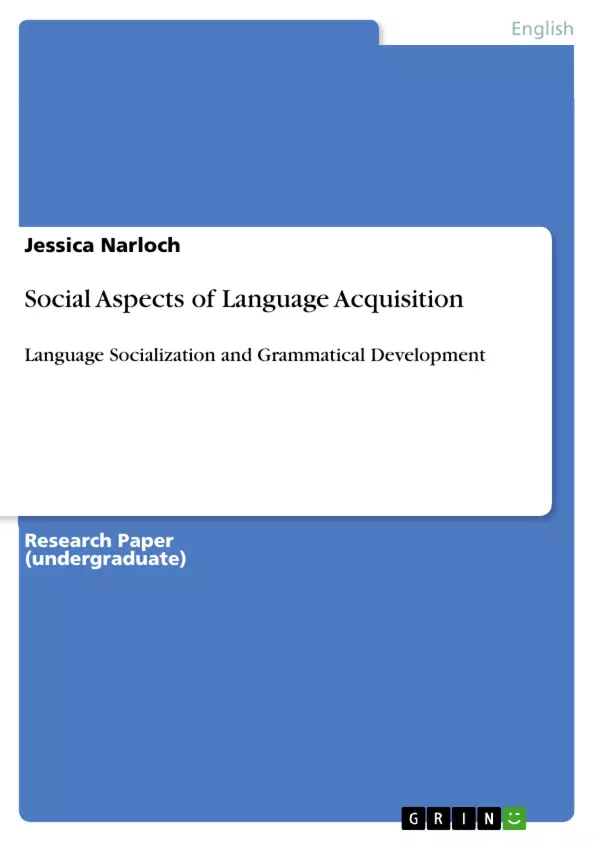There are many ways of talking to children and preverbal infants and also a great
variety of opinions about how important the child’s environment is or if it plays a
role at all. The question is not only how and why children understand
grammatical forms and language (Ochs & Schieffelin 1995: 73), but also which
role other aspects, such as Parentese and Baby Talk, play. Are they necessary or
totally unimportant? Should parents talk to their children at all or is it senseless
because they do not understand what the parents say to them? Some people are of
the opinion that Parentese only plays “a minimal role” (Garnica 1977: 63)
whereas other people think that the verbal environment is important. In how far is
the acquisition of language “the result of a process of interaction between mother
and child” (Snow 1977: 31)? By explaining some aspects of talk to children, such
as Parentese, Baby Talk, expansion, correction, imitation and by giving examples
of children being socialized through language, the question about which role these
aspects really play in first language acquisition should be answered.
Inhaltsverzeichnis (Table of Contents)
- Introduction
- Children as Addressees
- Differences in Cultures
- USA, Canada and Europe
- Other Societies
- Differences in Simplification
- USA, Europe, Tamil, Inuit
- Javanese, Kaluli and Samoan
- Parentese
- Definition
- Aspects of Parentese
- Importance of Parentese
- Baby Talk
- Prosodic Modifications
- Grammatical Modifications
- Lexical Modifications
- Phonological Modifications
- Discourse Modifications
- Other Forms of Baby Talk
- Differences in Cultures
- Children as Speakers
- Expansion
- Imitation
- Correction
- Use of Grammatical Forms
- Grammatical form as frequent but inappropriate for child use
- Samoan
- Kaluli
- Grammatical form as infrequent but appropriate for child use
- Kaluli
- Samoan
- Grammatical form as frequent but inappropriate for child use
Zielsetzung und Themenschwerpunkte (Objectives and Key Themes)
This paper examines the social aspects of language acquisition, particularly focusing on the role of language socialization and grammatical development. The primary objective is to analyze the importance of various forms of communication with children, such as Parentese and Baby Talk, in shaping their language acquisition process. The paper aims to shed light on the influence of these practices on children's understanding and production of language.- Cultural variations in addressing children
- The influence of simplification strategies in child-directed speech
- The role of Parentese and Baby Talk in language acquisition
- The relationship between language socialization and grammatical development
- The impact of cultural and societal perspectives on language acquisition
Zusammenfassung der Kapitel (Chapter Summaries)
This section will provide a summary of the key points from each chapter, excluding the Conclusion and any sections containing spoilers.Introduction
The introductory chapter delves into the diverse ways of communicating with children and preverbal infants, exploring varying viewpoints on the significance of the child's environment in language acquisition. It questions the roles of Parentese and Baby Talk in this process, examining whether these forms of communication are crucial or irrelevant. The chapter also addresses the debate surrounding the effectiveness of parent-child communication and its impact on language development.Children as Addressees
This chapter focuses on the cultural variations in addressing children. It highlights the contrasting approaches between societies like the USA, Canada, and Europe, where children are actively engaged in conversation, and societies like the K'iche' Mayan and Javanese, where children are considered overhearers of adult communication. The chapter discusses the role of simplification strategies, such as Parentese and Baby Talk, in different cultures and the impact these strategies have on the child's language learning experience.Children as Speakers
This chapter shifts the focus to the child's role as a speaker. It explores various strategies used by caregivers to facilitate language development, including expansion, imitation, and correction. The chapter analyzes the effectiveness of these techniques in promoting the child's language skills and understanding of grammatical structures.Use of Grammatical Forms
This chapter investigates the use of grammatical forms by children. It examines instances where children employ grammatical forms frequently but inappropriately, such as in Samoan and Kaluli cultures. It also explores the opposite scenario, where children utilize grammatical forms infrequently but appropriately, as seen in Kaluli and Samoan communities. The chapter aims to understand the influence of cultural practices and language socialization on the development of grammatical competence.Schlüsselwörter (Keywords)
The central keywords and topics explored in this text encompass language acquisition, language socialization, Parentese, Baby Talk, cultural variations, simplification strategies, grammatical development, and the impact of societal perspectives on child language development. The study examines the interplay between social interactions and the acquisition of language, highlighting the influence of cultural practices and caregiver communication on the child's linguistic development.- Quote paper
- Jessica Narloch (Author), 2006, Social Aspects of Language Acquisition, Munich, GRIN Verlag, https://www.grin.com/document/186300



